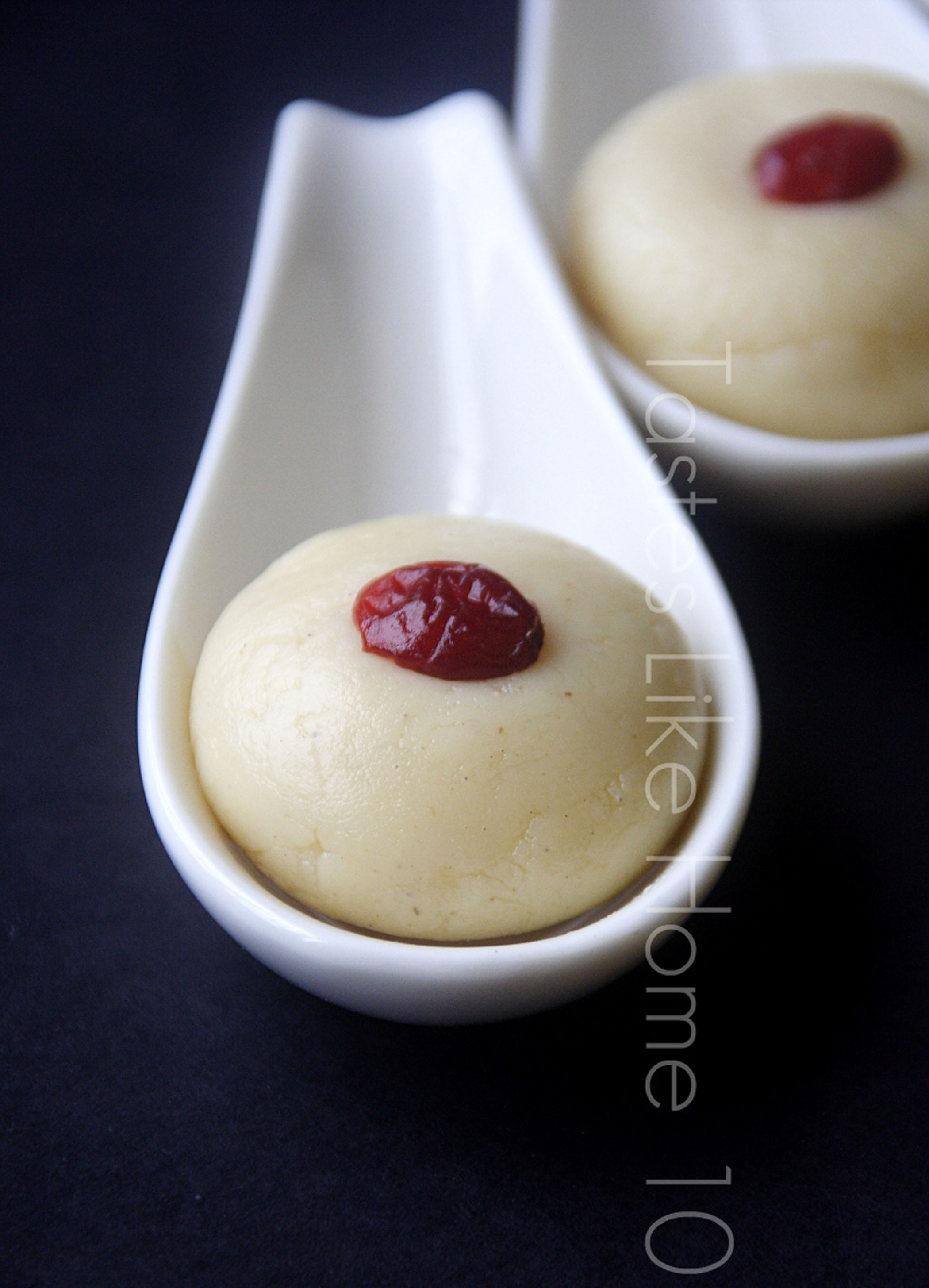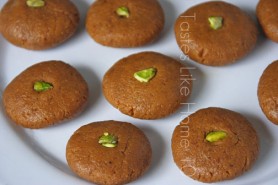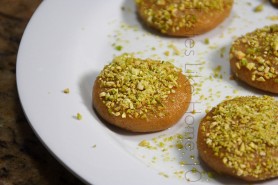Hi Everyone, Making Peera (Peda) from scratch is no simple task. It requires patience and determination, traits I felt I possessed, but I did not know to what extent until I made Peera. This is not to say that at one point in the process I did not want to lift the pot from the stove, toss it into the sink, fill it with water, and give up!
Let me start at the beginning.
With Diwali approaching, I had been getting lots of requests for a Peera recipe. Peera is an Indian sweet meat; it is a soft fudge that’s made on special occasions such as the Hindu festival of Diwali, the birth of children, weddings, etc. Given that I generally like to test a recipe before I send it out, I was determined to do so this past week so that I can make my readers happy. I did my homework – I researched and analyzed a number of recipes and techniques. Some recipes used the from-scratch method while others used shortcuts. I am not prone to taking short cuts when it comes to certain things for I believe that there are lessons to be learnt along the way. I wanted to make the Peera from scratch so that when, and if I did use or recommend the shortcut, that I would be doing so with some degree of authority and know-how.
The ingredients fo r Peera are simple. You need whole milk, white sugar and ground cardamom to add flavour. That’s it. Three ingredients. I knew going in that I would be spending at least four hours making Peera. I started promptly at 7.10 in the morning, little did I know that at 5 pm I’d still be in the kitchen making a second batch of Peera, and little did I know that the following day, I’d head back into the kitchen to start the process all over again for the third time! Sheer madness!
r Peera are simple. You need whole milk, white sugar and ground cardamom to add flavour. That’s it. Three ingredients. I knew going in that I would be spending at least four hours making Peera. I started promptly at 7.10 in the morning, little did I know that at 5 pm I’d still be in the kitchen making a second batch of Peera, and little did I know that the following day, I’d head back into the kitchen to start the process all over again for the third time! Sheer madness!
The preamble
Peera is traditionally made with khoya/khova – whole milk that has been cooked low and slow by being stirred continuously until the milk has significantly reduced in volume, all the water evaporated and the milk solids combined to make a soft lightly coloured dough. It takes hours to make khoya.
The making of Peera is very similar to making khoya because the milk has to reduce in volume from 4 cups to 1 cup (this varies depending on how much milk you start with). Then sugar has to be added which then produces a lot of liquid. The sugar and reduced milk mixture is cooked low and slow, stirred continuously so as not to scorch or ever come to a boil until it becomes a moist, pasty dough that leaves the sides of the pot or pan cleanly.
There are only 2 extremely important things to note about making Peera. Actually, make that 3 extremely important things:
1. You must have time to make the Peera, honestly, you can’t move away from the stove.
2. You must stir the pot continuously in order to prevent scorching and to ensure that the Peera has the right colour – light cream.
3. You have to watch the mixture carefully in the last stage to see exactly when to remove it from the heat.
Day one
Peera Making Batch # 1
Start time 7.10 am
End time: 11.50 am
Hour No. 1 – Milk in the pot, heat on medium. Brought the milk to a boil then reduced the heat to low. As instructed from one recipe, for the first hour, I stirred the milk every 3 to 5 minutes. So far, so good – no scorching, milk has reduced a little.
Hour No. 2 – Milk continues to cook on low and I figure that I can stir intermittently, I don’t need to physically sit or stand by the stove to stir all the time. I busy myself doing other minor things in the kitchen and I keep stirring every 3 – 5 minutes. I do notice some times that when I get back to the pot, the milk is simmering and changing colour slightly but really, nothing to be alarmed about. Later, I begin to notice just a tiny smidgen of scorching. Quickly got rid of that by standing and stirring continuously.
Hour No. 3 – Things seem to be under control; no more scorching and so again I move away and come back to stir every 3 – 5 minutes. The milk has now reduced significantly and it looks like the colour of evaporated milk. Cool I think. So this is how one can make homemade evaporated milk. At the end of the hour, I measure to ensure that the milk is one full cup and no more, before I add the sugar.
I add the sugar and just as I thought, the volume increases and the thick creamy milk becomes a bit watery. At this point I begin to think how counter-productive this method seems. Why spend 3 hours reducing the milk only to add sugar, which is adding liquid to the pot? And then after the sugar is added, you have to spend at least another hour stirring as you wait for the milk-sugar mixture to reduce. You see what I mean? Does not seem to make sense.
Hour No. 4 – Anyway, I added the sugar and stirred until it was dissolved. Double-checked that the heat was still very low and I moved away and came back to stir every 3 – 5 minutes. Bad idea – the mixture is quickly scorching now because of the sugar and because I am not stirring continuously. I try my best to remove the scorched bits that surface whenever I’d stir. By this time, the mixture is now brick red and it is not supposed to be that colour! I can’t turn the heat any lower, the only other stage would be to turn the stove off completely! Besides, the mixture still looks too wet! Panic steps in, I want to toss the pot in the sink but I don’t. I decided that I could not wait for the mixture to get any drier so I quickly stirred in the cardamom and removed the pot from the heat. Transferred the mixture to a greased plate to cool.
In a split second I make the decision that I am starting the process all over again. Mind you, this is after spending more than 4 hours making this first batch of Peera. At this point in time I was like a crazed woman, totally in a zone where determination took over (more like insanity). This time, I decided to do it differently. I am going to make khoya and then knead in the sugar and cardamom. Doing it this way should save me an hour at least because then I don’t have to deal with the liquid that would result from heating the sugar.
Peera Making Batch # 2
Start time: 12 noon
End time: 5 pm
The first hour goes by uneventfully. I stir every 3 – 5 minutes; the milk has reduced a little. The second hour arrives, and this time, I stir continuously for longer periods of time, step away for about 3 minutes and then repeat the process. Hour 3 came, I did not have to measure for a 1-cup reduction this time, remember I am making the khoya? I just have to let the liquid evaporate, let the milk solids combine and come away easily from the sides of the pot.
Three and a half hours later, I am standing thinking that this khoya should have been done by now but it is still so wet… I couldn’t understand why. That’s when it struck me. I was now using a different pot, one that is deeper and not short and wide as the previous one so the evaporation was taking longer.
As the khoya came together, I noticed that it was not quite as light in colour as I had hoped. I knew immediately that it was because I kept moving away thinking that the longer periods of stirring in between would do the trick. Anyway, it was certainly not as red at the first set. Actually, I liked the colour; it looked like fudge.
The sugar and cardamom were kneaded into the khoya when it is was still warm but cool enough to handle. I shaped them into Peera and set them aside.
All night I tossed and turned and literally dreamt about making the Peera. I was a tormented soul. Here’s why, while the Peera looked and tasted good, the colour was off, way off. It is supposed to be a very light cream.
Day two

Peera Making Batch # 3
Start time: 8 am
End time: 11.15 am
Milk in the pot, brought to a boil and then heat reduced to low. I stood at that stove for 3 hours and 15 minutes stirring non-stop. I had only paused long enough to add in the sugar, as counter-productive as it seemed. Let me tell you, I had no intentions of letting the Peera making get the better of me. I stirred with my right hand and when that hand got tired, I switched to my left hand. I shifte
d my weight from one leg to the other. I leaned against the stove. I stared out of the window looking at nothing in particular. And then I started to talk to myself. Not aloud!
I asked myself what it is that I am doing. Why am I so determined to make this Peera? It is not as if I like sweet things. But it’s not for me I counter-argued with myself. You do know that this is not your bread and butter job right? You do realize that you have a class to prepare for tomorrow? And on and on it went this to and fro with myself and how I can get at times.
The slaving
away at the stove without moving paid off – there was no scorching and no changing of colour. The best part is that because I used the wide pot I had originally used when I first a
ttempted making the Peera, the time had reduced by a whole hour! The wider the pot or pan used the faster the evaporation takes place.
I rolled my Peera when the mixture was cool enough to handle and gazed upon them triumphantly.
Taste testing
● There were 8 taste testers for the 3 sets of Peera.
● Each batch of Peera was different – in taste, texture, flavour and appearance.
● Each batch of Peera was made with the same ingredients and the exact amount of ingredients – 4 cups whole milk, ¾ cup white sugar and ¼ teaspoon freshly ground cardamom (elaichi).
● Batches 1 and 3 were made usin
g a similar method; the difference being that batch 3 was stirred continuously while batch 1 was stirred intermittently.
● Batch 2 had a completely different method of preparation.
● The Peera(s) are ranked overall from 1 to 3 – 3 being the least favourite and 1 being the best.
Let’s start with third place. The least favourite of the Peera was batch # 2. This is the one where the khoya was made first and then the sugar and spice kneaded in to form a dough. The texture was a bit grainy from the sugar and the cardamom was highly pronounced. The intense cardamom flavour was a little off-putting to most of the tasters. Part of it was because some of them had never tasted cardamom before and wondered aloud if it was ginger. The texture was softer than the other two and did not taste as uniform as the others. You could taste that there were three components that had been put together rather melded or cooked as one.
In second place was Peera batch # 1. Everyone liked the colour; it was brown and looked like the fudge with which they are familiar. The cardamom flavour was less pronounced but nevertheless evident. The texture was firmer and the taste was more complex – this was due to the caramelization of the sugar. There was almost a nuttiness to the Peera from this batch.
First place went to Peera batch # 3. There was smoothness to the taste of this Peera; it was creamy. The cardamom was there – subtle and inviting. People kept eating and asking, what is that? There is some spice in there that I can’t place. When I told them it was cardamom, some were filled with disbelief. Unlike the previous tastings, people were reaching for seconds with this batch. You’d finish one and long for another one. That, I understand, is supposed to be the lure of a proper Peera.
I ask you, yes you reading this column at this very moment. Are you up to the challenge of making Peera from scratch? How patient are you? Got 4 hours to spare? Yeah? Okay. Give it a shot and drop me a line and let me know it turns out, or not.
Peera (Peda)
Yield: 10 – 12
Ingredients
4 cups whole milk
¾ cup sugar
¼ teaspoon ground cardamom
Directions
1. Add the milk to a wide-mouth pot with a thick or heavy bottom. Place on medium heat and bring to a boil. As soon as the milk comes to a boil, reduce the heat to low. Using a rubber spatula, stir the milk every 3 minutes for 1 hour to avoid the milk scorching. Be sure to run the spatula along the sides of the pot as well to avoid the milk hardening at the sides. At no time is the milk to come to a boil again; it should remain very hot. No skin should form on top of the milk either.
2. When the first hour is complete, stir the milk continuously; do not ever stop. The milk should remain white or very light in colour. Now the aim is to keep stirring until the milk reduces to 1 cup. Depending on the size and width of pot you are using, the milk can reduce to the 1 cup at the end of the second hour or at the end of the third hour. The best thing to do is measure it.
3. When the milk has reduced to 1 cup, it will thicken but it should still remain white. Add the sugar and keep stirring continuously; the sugar has to melt. The mixture will become watery, do not worry, this is normal; just keep stirring. Don’t forget to run the spatula along the sides of the pot too, not just the bottom.
4. Keep stirring until the mixture thickens. You will notice that it comes away easily and cleanly from the sides of the pot. The minute you stir and see that the mixture leaves a slight trail at the side or bottom of the pot, remove it from the heat and quickly stir in the cardamom until it is fully incorporated into the mixture. At this stage, the mixture will be like a thick paste, don’t worry, it will dry out as it cools. It is important to note that it should not be runny-wet, just a thick paste that moves.
5. Transfer the mixture to a plate that has been brushed with some ghee or vegetable oil. Let the mixture cool until you can handle it. You want it to still be warm so that you can shape it into Peera.
6. Rub a little ghee or oil on your hands and take the mixture a little at a time and roll them into balls and slightly flatten them between the palms of your hands. Place on a greased plate.
7. The Peera can be served as is or you can choose to decorate them with dried fruit such as raisins or dried cranberries as I have. Or, you can used chopped or whole nuts – pistachio, cashew or almonds.
Happy Diwali!
Cynthia
Cynthia@tasteslikehome.org
www.tasteslikehome.org







